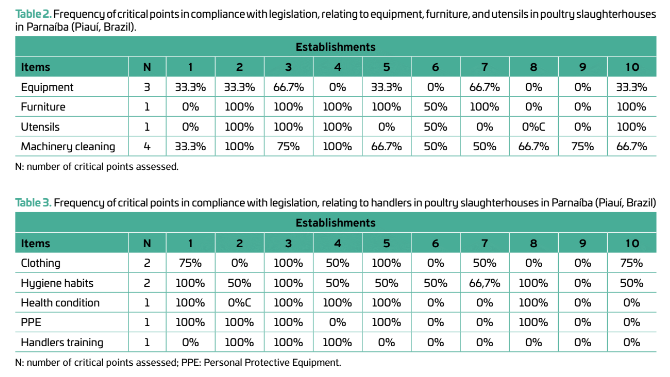Physical and hygienic-sanitary conditions of poultry slaughterhouses in the municipality of Parnaíba, Piauí, Brazil
DOI:
https://doi.org/10.21708/avb.2021.15.4.10171Abstract
This study aimed to evaluate the physical and hygienic-sanitary conditions of poultry slaughterhouses in the municipality of Parnaíba, Piauí, Brazil. Ten slaughterhouses were visited, using a checklist as an evaluation criterion, seeking to assess the physical and hygienic-sanitary conditions of facilities, equipment, handlers, environment, production, and food transportation, during the entire slaughtering process, to verify compliance with current legislation. The slaughterhouses visited (10 / 100%) had no Official Inspection Service and did not obey the rules established by legislation, showing precarious physical and hygienic-sanitary conditions of operation. Most of the establishments (9 / 90%) were located in the urban area and one (10%) in the rural area. None of them followed the animal welfare recommendations. Moreover, seven (70%) establishments had no waste treatment and the residues were dumped in an open area. Therefore, it was concluded that the hygienic-sanitary conditions of poultry slaughterhouses in Parnaíba pose risks to meet quality and the health of slaughterhouses employees and people who consume the products from those establishments.
Downloads

Downloads
Published
Issue
Section
License
Autores que publicam na Acta Veterinaria Brasilica concordam com os seguintes termos: a) Autores mantém os direitos autorais e concedem à revista o direito de primeira publicação, com o trabalho simultaneamente licenciado sob a Licença Creative Commons Attribution que permite o compartilhamento do trabalho com reconhecimento da autoria e publicação inicial nesta revista. b) Autores têm autorização para assumir contratos adicionais separadamente, para distribuição não-exclusiva da versão do trabalho publicada nesta revista (ex.: publicar em repositório institucional ou como capítulo de livro), com reconhecimento de autoria e publicação inicial nesta revista. c) Autores têm permissão e são estimulados a publicar e distribuir seu trabalho online (ex.: em repositórios institucionais ou na sua página pessoal) a qualquer ponto antes ou durante o processo editorial, já que isso pode gerar alterações produtivas, bem como aumentar o impacto e a citação do trabalho publicado (Veja O Efeito do Acesso Livre).


 Esta obra está licenciada com uma Licença
Esta obra está licenciada com uma Licença 